Published: 8 April 2021
Corona crisis dropped the demand for accommodation services to the level of the 1990s
Due to the corona crisis, overnight stays at Finnish accommodation establishments decreased to the level of 1995. The number of overnight stays by resident tourists in 2020 decreased by 25 per cent and that of overnight stays by non-resident tourists by as much as 68 per cent from the previous year. In 2020, a total of 14.3 million overnight stays were recorded at Finnish accommodation establishments.
Because of the corona crisis, the year 2020 was very exceptional for accommodation services. The year started with a growth of around seven to eight per cent in overnight stays in January to February. However, the pandemic that started in March began to decrease clearly the number of visitors. In April, the number of nights spent by resident tourists decreased by 86 per cent and that of nights spent by foreign tourists by around 95 per cent. In 2020, a total of 12.0 million overnight stays were recorded for resident tourists and 2.3 million for non-resident tourists. During July to August, the number of nights spent by resident tourists was close to the level of 2019, but from September to December, the decline in overnight stays by resident tourists remained at around 20 per cent. Overnight stays by foreign tourists decreased by around 85 per cent from May to December from the year before.
Year-on-year changes in nights spent (%) by month, 2020/2019
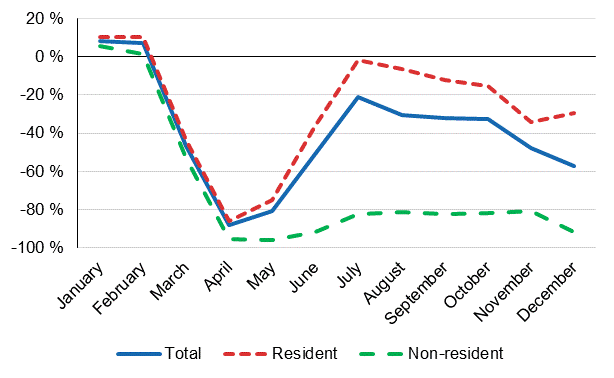
Domestic demand was upheld by leisure trips
For the whole year, overnight stays by resident tourists showed a drop of one quarter from the year before. The number of overnight stays did not reach the level of the previous year in any region, but in some of the regions overnight stays decreased clearly more strongly than in others. Overnight stays by resident tourists decreased by 45 per cent in Uusimaa, where overnight stays decreased by 46 per cent in Helsinki and by 56 per cent in Vantaa. In sparsely populated areas, year-on-year changes were considerably more moderate. In North Ostrobothnia, overnight stays by resident tourists decreased by around seven per cent and in Kainuu by eight per cent. The number of nights spent by resident tourists in Kuusamo was four per cent higher than in 2019.
Year-on-year changes in resident nights spent (%) by region, 2020/2019
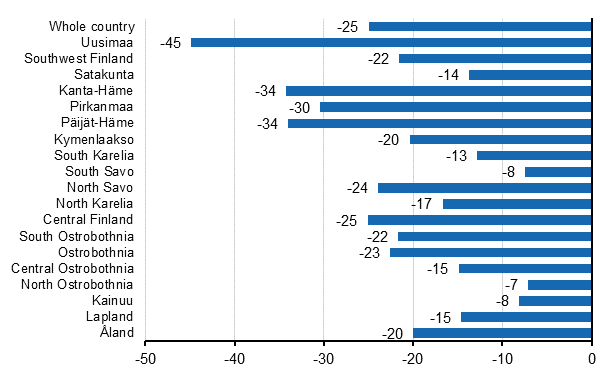
There were also differences in overnight stays by resident tourists between leisure trips and business trips. For leisure trips, overnight stays by resident tourists were almost on level with the previous year in July to August. However, overnight stays related to business trips remained clearly lower after spring. In July to September, around one-quarter fewer overnight stays were recorded for business trips, but in October to December as much as nearly 40 per cent fewer.
Year-on-year changes in nights spent (%) by month and trip purpose, 2020/2019
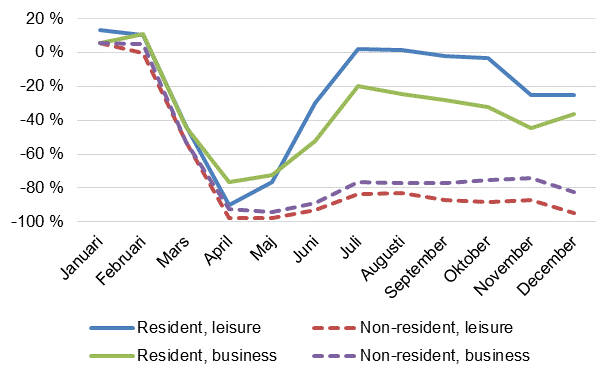
Difficult year for accommodation establishments
The weakening in the demand for accommodation services was clearly reflected in the available capacity of accommodation establishments. During the year, an average of 1,100 establishments were open, offering around 56,000 rooms and 144,000 beds. Many accommodation establishments have been forced to close doors temporarily because of the pandemic, which has resulted in lower capacity being available than before. The number of open establishments decreased by 83 and available were over 9,000 fewer rooms and over 18,000 fewer beds than in the year before. Despite the contraction in availability, the occupancy rate of rooms fell by 16 percentage points, being around 37 per cent, on average. The occupancy rate of rooms is calculated from the available capacity of the open establishments.
Hotel room occupancy rate (%) and the monthly average price (EUR)
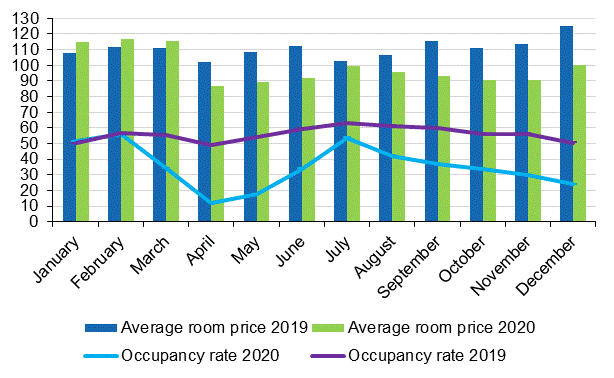
Overnight stays in hotels decreased by 43 per cent in the whole country and the occupancy rate also dropped by around 18 percentage points from the previous year. Thus, the average hotel occupancy rate was about 38 per cent. The average price of hotel rooms fell by around EUR eight and was EUR 102 per night. The fall in the demand for hotel stays has been stronger than in other types of accommodation. Regional differences are also visible in that the drop is stronger in larger towns than in sparsely populated areas.
The decrease in overnight stays was not as big in other accommodation establishments than hotels. In other accommodation establishments, overnight stays by resident tourists decreased by three per cent from the year before, while in hotels they went down by 31 per cent. For foreign tourists, the change in the number of overnight stays is closer to one another for hotels and other accommodation establishments: overnight stays by foreign tourists in hotels decreased by 69 per cent and in other accommodation establishments by 61 per cent from one year ago. For domestic tourists, the difference can be explained by that tourists have favoured establishments where they can have more space for their overnight stay and fewer human contacts.
Hardly any foreign tourists since March
Last year, there was a distinct collapse in the travel of foreigners to Finland. However, the most important countries of origin remained almost unchanged from previous years. In 2020, Russian, German and British tourists were the three largest groups of foreign citizens. This is explained by trips made in January to February, when the restrictive measures imposed due to the pandemic had been implemented in only a few countries. In January to February, a majority of foreign tourists headed to ski resorts in Northern and Eastern Finland.
There were changes between the five most important countries of origin compared with previous years. The fourth and fifth largest groups were French and Estonian tourists, leaving behind Swedish and Chinese visitors that occupied the same positions in the previous year. The change can be explained by the corona restrictive measures imposed at different times in the countries of origin. Consequently, overnight stays by Swedish and Chinese tourists dropped by over 80 per cent from the year before.
Year-on-year changes in nights spent (%) by country of residence, 2020/2019
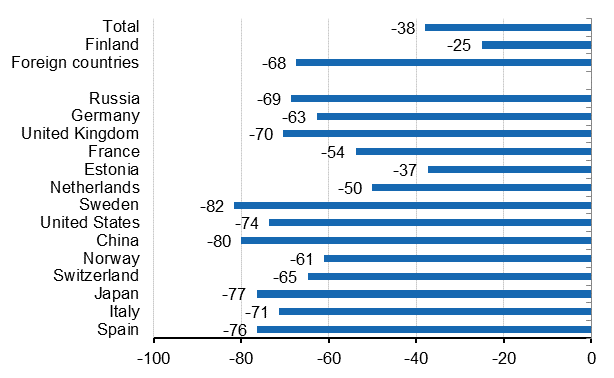
Source: Accommodation Statistics. Statistics Finland
Inquiries: Jussi-Pekka Rantanen 029 551 3547, Ossi Nurmi 029 551 2984, liikenne.matkailu@stat.fi
Head of Department in charge: Hannele Orjala
Publication in pdf-format (529.2 kB)
- Tables
-
Tables in databases
Pick the data you need into tables, view the data as graphs, or download the data for your use.
Appendix tables
- Appendix table 1. Capacity and its utilization in 2020 (8.4.2021)
- Appendix table 2. Nights spent in all establishments in 2020 (8.4.2021)
- Appendix table 3. Hotel capacity and capacity utilization in 2020 (8.4.2021)
- Appendix table 4. Nights spent in hotels in 2020 (8.4.2021)
- Appendix table 5. Visitor arrivals and nights spent by country of residence in 2020 (8.4.2021)
- Appendix table 6. Nights spent in all establishments by month in 2020 (8.4.2021)
- Appendix table 7.1. Nights spent by non-residents and annual change (%) in all establishments in 2020 (8.4.2021)
- Appendix table 7.2. Nights spent by non-residents and annual change (%) in all establishments in 2020 (8.4.2021)
- Appendix table 8.1. Nights spent by non-residents and annual change (%) in hotels in 2020 (8.4.2021)
- Appendix table 8.2. Nights spent by non-residents and annual change (%) in hotels in 2020 (8.4.2021)
- Appendix table 9.1. Capacity of accommodation establishments and capacity utilization by type of establishment in 2020 (8.4.2021)
- Appendix table 9.2. Capacity of accommodation establishments and capacity utilization by type of establishment, May-August 2020 (8.4.2021)
- Appendix table 10.1. Capacity of accommodation establishments by type of establishment in 2020 (8.4.2021)
- Appendix table 10.2. Capacity of accommodation establishments by opening season in 2020 (8.4.2021)
- Appendix table 10.3. Capacity of accommodation establishments by number of bed-places in 2020 (8.4.2021)
- Appendix table 10.4. Capacity of accommodation establishments by number of rooms in 2020 (8.4.2021)
Updated 08.04.2021
Official Statistics of Finland (OSF):
Accommodation statistics [e-publication].
ISSN=1799-6325. 2020. Helsinki: Statistics Finland [referred: 18.12.2025].
Access method: http://stat.fi/til/matk/2020/matk_2020_2021-04-08_tie_001_en.html

